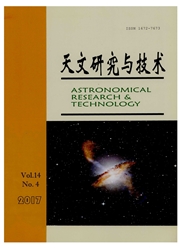

 中文摘要:
中文摘要:
指向误差是射电望远镜运行的重要性能指标之一。为保证射电流量的测量精度,一般要求射电望远镜的指向误差小于十分之一波束宽度。对佳木斯66 m射电望远镜的指向进行了大量的测量,详细分析了指向误差的分布。利用新的基本参数模型进行误差修正后,佳木斯66 m射电望远镜的指向误差仍然随方位和俯仰有较明显的变化。分析认为,这种变化趋势是方位轴与俯仰轴夹角和重力变形两个参量对方位俯仰变化的高阶项引起的。通过引入两个误差源的一阶展开项对基本参数模型进行改进,使佳木斯66 m射电望远镜的指向精度有了明显的提升,从45″改进到20″以内。
 英文摘要:
英文摘要:
Pointing accuracy is one of the most important characteristics for a large radio telescope; it is very fundamental for telescope running. To ensure good performance for measuring the flux density of a radio source, pointing accuracy must be kept within 10% of telescope beam size. In this paper we present results of large measurements of telescope points for Jiamusi 66m radio telescope, and show the basic-parameter model and the fitting residuals of pointing data. We find that even after the correction of a new best-fitting basic- parameter model, the pointing uncertainty data still have a systematic variations of concentration along with the azimuth and elevation, which we believe is caused by the high order variations of the angle between the azimuth axis and elevation axis as well as the gravity the pointing corrections, and we get much improved 45" to less than 20". deformation. We improve the basic-parameter model for pointing accuracy for Jiamusi 66m radio telescope from
 同期刊论文项目
同期刊论文项目
 同项目期刊论文
同项目期刊论文
 期刊信息
期刊信息
